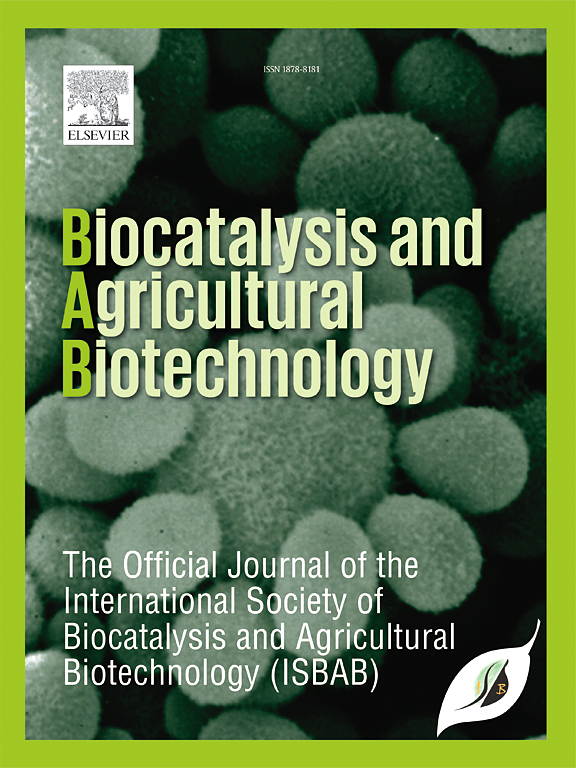含铁纳米颗粒的螺旋藻生物质:促进水稻生长和提高铁含量的新型生物肥料
IF 3.8
Q2 BIOTECHNOLOGY & APPLIED MICROBIOLOGY
引用次数: 0
摘要
目前的研究重点是开发一种纳米铁基植物肥料,以环境友好的方式提高作物品质。将螺旋藻生物质暴露于 pH 值为 5.5 的 0.05M FeCl3 溶液中 48 小时后,在黑暗条件下,纳米铁会在细胞内外合成纺锤形纳米铁。透射电子显微镜观察到的颗粒大小为 24.77 ± 5.264 nm。利用能量色散 X 射线光谱(EDX)和动态光散射(DLS)对其进行了进一步表征。比较了各种肥料的性能,包括由植物合成的纳米铁(INP)、干螺旋藻生物质(SB)和纳米铁负载螺旋藻生物质(即纳米植物肥料(NPF))制成的肥料与传统 NPK 肥料的性能。田间施肥的结果表明,NPF 比其他肥料更能显著改善水稻的生长。值得注意的是,与 NPK 相比,NPF 的芽长显著增加了 37.6%,作物产量提高了 47%,稻米的粒重增加了 15%。NPF 处理过的植物的糙米和精米的含铁量(44% 和 28%)均高于 NPK 处理过的植物。此外,成本效益分析强调了 NPF 相对于传统肥料的优越性,表明它是一种高效、环保的纳米铁基植物肥料。本文章由计算机程序翻译,如有差异,请以英文原文为准。
Spirulina biomass loaded with iron nanoparticles: A novel biofertilizer for the growth and enrichment of iron content in rice plants
The current investigation was focused to develop a nano-iron-based phycofertilizer to enhance crop quality in an environment-friendly manner. Biosynthesis of nano-iron occurred when Spirulina biomass was exposed to a 0.05M FeCl3 solution for 48h at pH 5.5 in the dark, resulting in the synthesis of spindle-shaped nano-iron both inside and outside the cells. The particles' sizes were 24.77 ± 5.264 nm as observed in transmission electron microscopy. Further characterizations were carried out using energy dispersive X-ray spectroscopy (EDX), and dynamic light scattering (DLS). The performance of various fertilizers, including those derived from phycosynthesized nano iron (INP), dried Spirulina biomass (SB), and nano-iron loaded Spirulina biomass i.e., nano-phycho-fertilizer (NPF) was compared against conventional NPK fertilizer. The results from field applications indicated significant improvements in rice, with NPF outshining the rest. Notably, NPF demonstrated a remarkable 37.6% increase in shoot length, a 47% boost in crop productivity, and a 15% rise in grain weight of rice compared to NPK. Both unpolished and polished grains of NPF-treated plants contained higher iron contents (44% and 28%) than the NPK-treated plants. Furthermore, the cost-effectiveness analysis underscored the superiority of NPF over conventional fertilizer, representing it as a highly effective and eco-friendly nano-iron-based phycofertilizer.
求助全文
通过发布文献求助,成功后即可免费获取论文全文。
去求助
来源期刊

Biocatalysis and agricultural biotechnology
Agricultural and Biological Sciences-Agronomy and Crop Science
CiteScore
7.70
自引率
2.50%
发文量
308
审稿时长
48 days
期刊介绍:
Biocatalysis and Agricultural Biotechnology is the official journal of the International Society of Biocatalysis and Agricultural Biotechnology (ISBAB). The journal publishes high quality articles especially in the science and technology of biocatalysis, bioprocesses, agricultural biotechnology, biomedical biotechnology, and, if appropriate, from other related areas of biotechnology. The journal will publish peer-reviewed basic and applied research papers, authoritative reviews, and feature articles. The scope of the journal encompasses the research, industrial, and commercial aspects of biotechnology, including the areas of: biocatalysis; bioprocesses; food and agriculture; genetic engineering; molecular biology; healthcare and pharmaceuticals; biofuels; genomics; nanotechnology; environment and biodiversity; and bioremediation.
 求助内容:
求助内容: 应助结果提醒方式:
应助结果提醒方式:


